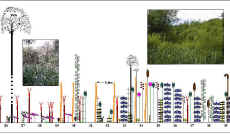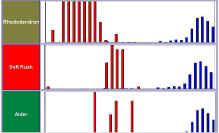The numbered percentages next to each species are the
mean % cover of the species in the respective zones.
The figures for the dry land and marsh areas are derived from the amalgamated mean values
from both the N/S and E/W transects. The figures for the two swamp areas (southern and
western) are each derived from the single transects crossing these areas. The open water
data comes from the N/S transect, which was the only one to cross open water. Diagram
Those with a head for figures may note that the % cover
figures in several of the columns add up to well over 100%. This is because the vegetation
in the wetland is layered vertically. One plant may completely overlap another so that the
total percentage cover in a single quadrat may be several hundred percent.
The dry land areas of the wetland are dominated by tree
species, which because of their size naturally cover large areas. Rhododendron is still
the dominant species in this region. The marsh area adjoining the dry land zone, where conditions
are too wet to suit the Rhododendron, prevents it from encroaching further. However, it is
easy to see that if the wetland were allowed to silt up to any extent, the Rhododendron
would once more rapidly cover the area.
Rhododendron is a non-native species which is often extremely invasive. Another such
species, Japanese Knot Weed, also occurs in the wetland area (species
list). Unlike Rhododendron, this species thrives in wet conditions. It therefore has
to be controlled and removed from the wetland as far as possible at frequent intervals.
The table illustrates the point already made, that
different species overlap zones within the wetland. Willow is one of the six dominant
species in three of the zones. Yellow Iris and Water Mint are also dominant in more than
one zone.
The tallest layer in the marsh area is made up of young
Willow trees. Under and between these small trees (approximately 2 -3metres in height),
Yellow Iris and Wood Clubrush dominate in a layer slightly over 1 metre high. Water Mint
twines in amongst their stems, gaining support from the adjacent vegetation. Surprisingly,
one of the dominant species in this region in the moss, Eurhynchium praelongum.
This is predominantly a wet woodland species, although it has a marsh form. This clothes
the bases of the plant stems in much of the marsh area.
The two swamp zones are very different to each other,
with different dominant species. Only Water Mint and Branched Bur-reed are common to both.
The Branched Bur-reed is much more common in the southern marsh area than in the western.
The difference between them is likely to be due to the fact that the western swamp area
has the stream flowing into it. There is therefore constant current and high water depths.
The only plant in the open water zone picked up by the
belt transect was Canadian Pondweed. It should also be noted that the floating Common
Duckweed tended to be confined to the swamp areas. This is because the emergent plant
stems provide barriers to its movement. On the open water, it drifts and is carried off by
minor currents and wind to collect in marginal areas.


